The TASCAM 58 and 58-OB were TASCAM's first +4dB multitrack recorders and were specifically targeted at serious production professionals. Later that year TASCAM introduced the TASCAM 52 1/4" 2-channel half-track  mastering and broadcast on air recorder/reproducer. They also introduced the M-30, the replacement for the Model 3. The new model 30 included parametric EQ and phono preamps. The model M-35, an 8-in, 4-out, 8 monitor (8x4x2) mixer, offered modular construction and the option of adding the model M-35EX expansion module. The M-35EX gave expansion capability up to 28 inputs.
mastering and broadcast on air recorder/reproducer. They also introduced the M-30, the replacement for the Model 3. The new model 30 included parametric EQ and phono preamps. The model M-35, an 8-in, 4-out, 8 monitor (8x4x2) mixer, offered modular construction and the option of adding the model M-35EX expansion module. The M-35EX gave expansion capability up to 28 inputs.
The TASCAM M-50 was a 12 input, 8-buss mixer with 2 independent aux systems.
The TASCAM M-16 was a mixer with 16 inputs, 8 outputs, and a 16-channel monitor section. This board was made in either a 16 input or 24 input configuration, a real flexible mixer that you could buy it with 16 inputs and then add modules later to increase the inputs to 24.
 Following the success of the 122, TASCAM targeted the multi-image market with the model 133, a professional 3 track cassette deck specialty product with 2 tracks of stereo audio and a cue track. The 133 was a huge success and dominated the multi-image production and presentation market.
Following the success of the 122, TASCAM targeted the multi-image market with the model 133, a professional 3 track cassette deck specialty product with 2 tracks of stereo audio and a cue track. The 133 was a huge success and dominated the multi-image production and presentation market.
The TASCAM 234 Syncaset was the first 4-track rackmountable cassette recorder/reproducer with dbx and 3 3/4 IPS tape speed.
1984 The TASCAM 225 Syncaset was the next generation 2 track, 4 channel cassette deck. It was priced at $350.
Teac released its new generation of reel to reel tape recorders for the consumer market. They were some of the last reel tape recorder produced by Teac. They included the X-700R and the X-2000R reel tape recorders.

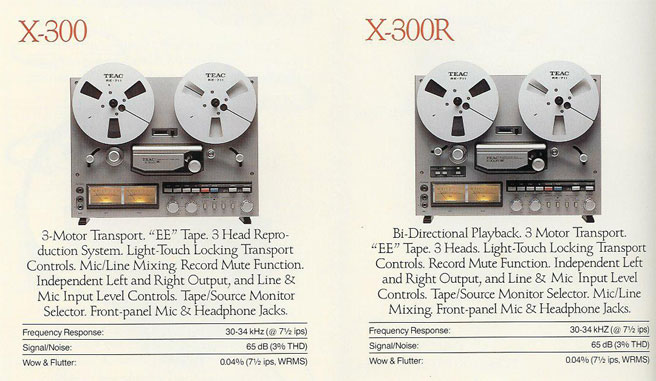
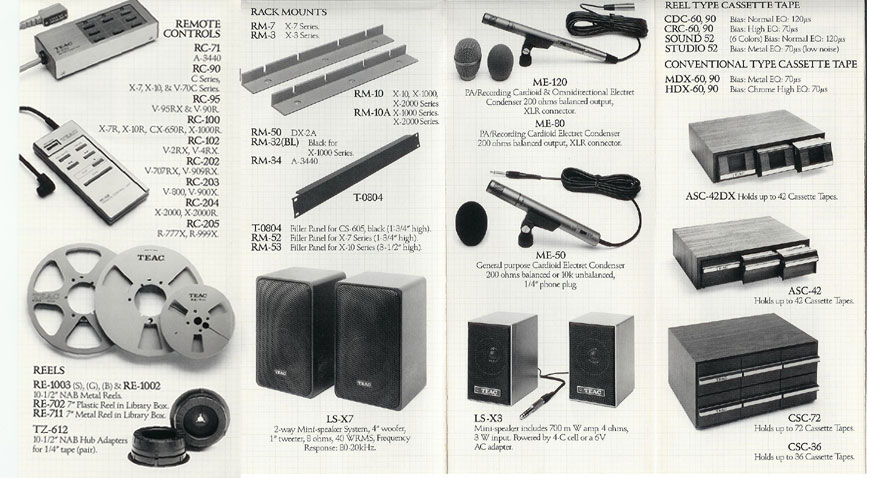
TASCAM introduced its first battery operated (4 track) portable studio, the PORTA ONE MINISTUDIO, which operated on both AC power and D cell batteries. The PORTA ONE MINISTUDIO could record 4 tracks on a standard audio cassette.
TASCAM introduced the M-512 and M-520 audio production mixing consoles. These were TASCAM's first cost-effective balanced consoles. They came in two input configurations...12 x 8 and 20 x 8. These were priced starting at $3,995 suggested retail.
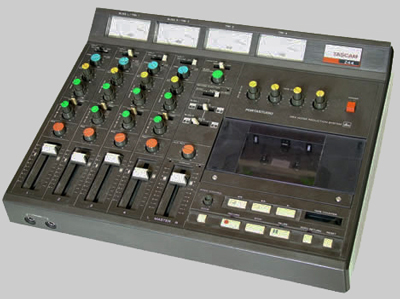 TASCAM introduced the model 244, the second generation Portastudio and the first featuring dbx noise reduction along with 2-band, 4-knobsweepable EQ.
TASCAM introduced the model 244, the second generation Portastudio and the first featuring dbx noise reduction along with 2-band, 4-knobsweepable EQ.
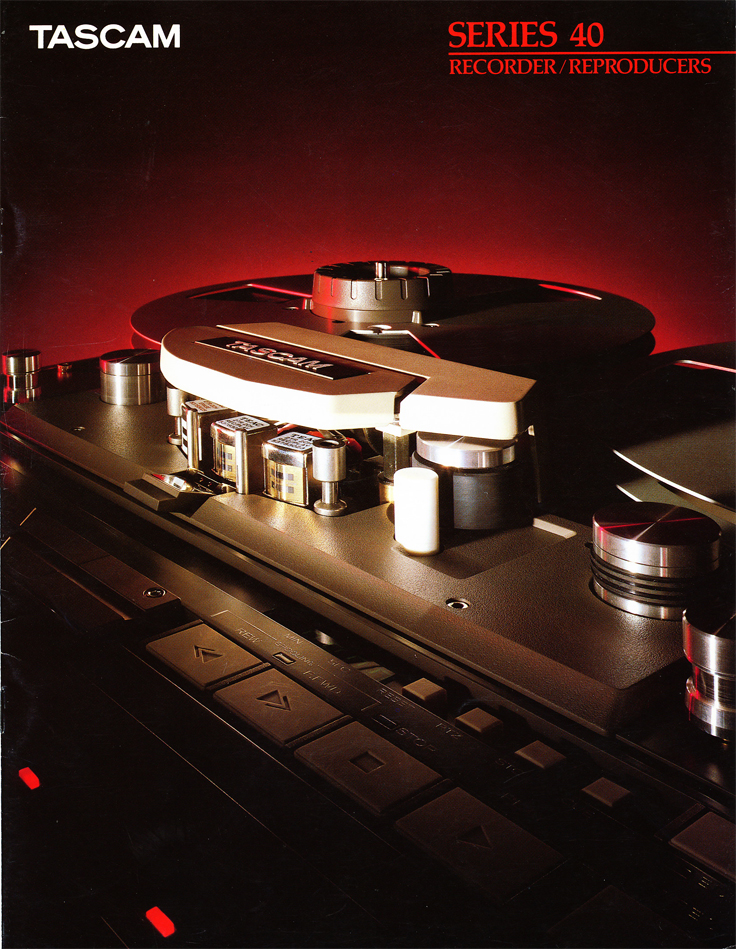
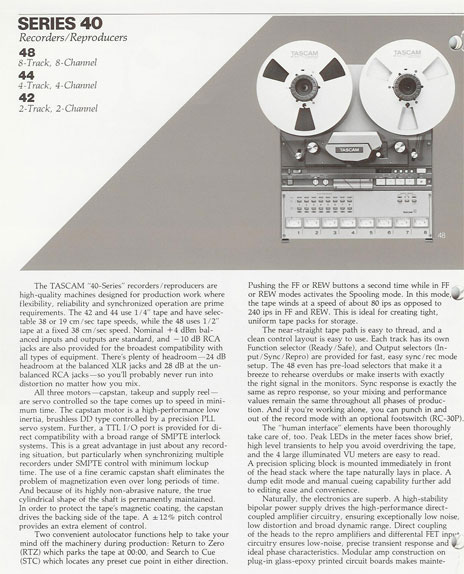 The TASCAM 40 series included the 42-NB 1/4" 2-track 2 channel half track mastering and broadcast on-air recorder/reproducer, the 44-OB 1/4" 4-track recorder/reproducer with10 1/2" reels and 15 IPS, and the 48-OB 1/2" 8 track 8 channel recorder/reproducer with SMPTE interlock capability.
The TASCAM 40 series included the 42-NB 1/4" 2-track 2 channel half track mastering and broadcast on-air recorder/reproducer, the 44-OB 1/4" 4-track recorder/reproducer with10 1/2" reels and 15 IPS, and the 48-OB 1/2" 8 track 8 channel recorder/reproducer with SMPTE interlock capability.
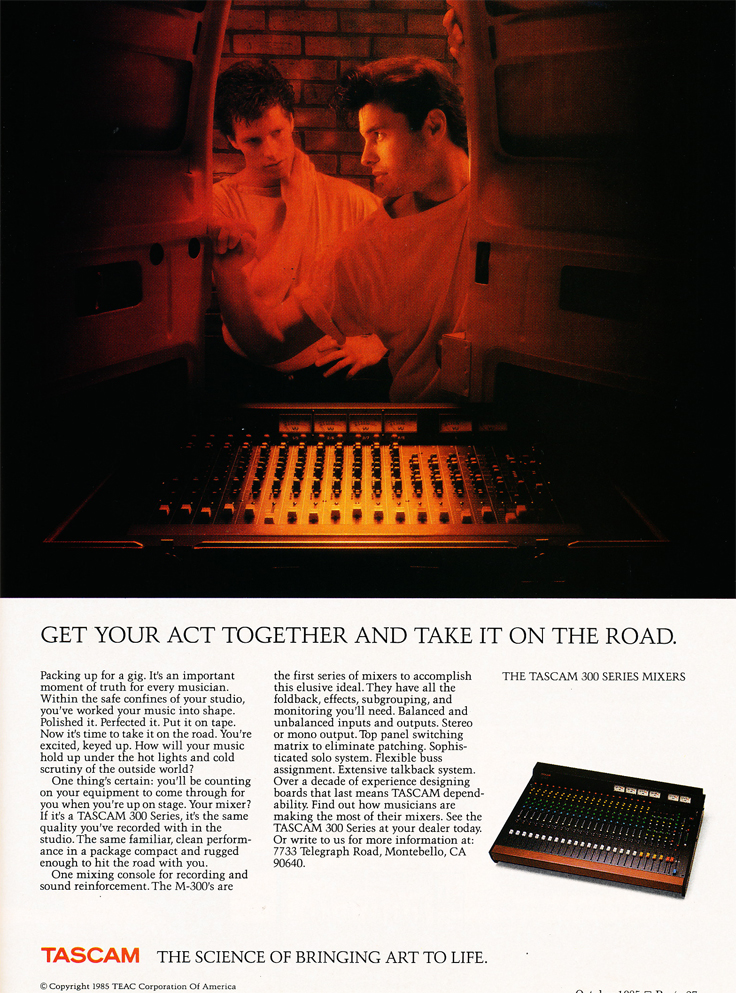
The TASCAM 300 series mixers consisted of the M-308 a (8 x 4 x 8), the M-312 a (12 x 4 x 8), and the M-320 a (20 x 4 x 8) mixer.
The TASCAM M-106 was the first rackmountable production audio mixing console (6 x 4 x 4) featuring six input channels with selectable mic, line or tape inputs, four channels with RIAA phono inputs and two aux sends. 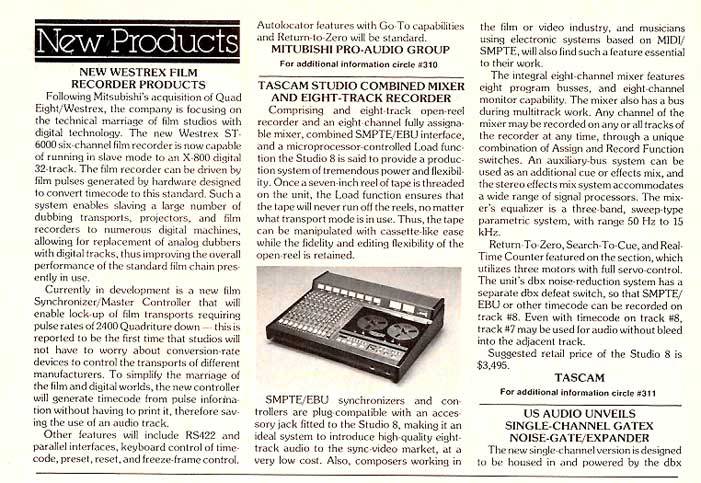
1985 TASCAM introduced a historic new invention, the TASCAM 388 Studio. The 388 was the first 8 track 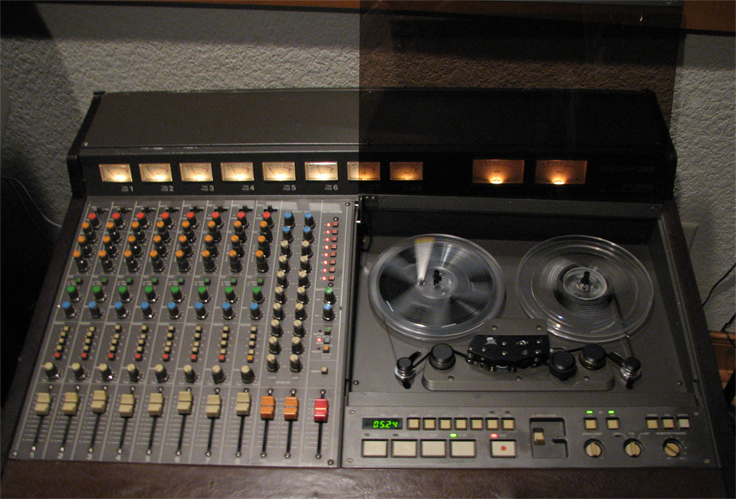 (8x8), 1/4" reel-to-reel multitrack tape recorder and mixer combination ever. The unit used a 7" reel of 1/4" tape and had an auto stop feature so it functioned just like a standard cassette for the user. The 388 was also SMPTE capable and had 8 tracks of dbx noise reduction. Its list price was under $4,000. To the left is the Tascam 388 8 track tape recorder in the Phantom Productions, Inc.'s Reel2ReelTexas.com
(8x8), 1/4" reel-to-reel multitrack tape recorder and mixer combination ever. The unit used a 7" reel of 1/4" tape and had an auto stop feature so it functioned just like a standard cassette for the user. The 388 was also SMPTE capable and had 8 tracks of dbx noise reduction. Its list price was under $4,000. To the left is the Tascam 388 8 track tape recorder in the Phantom Productions, Inc.'s Reel2ReelTexas.com
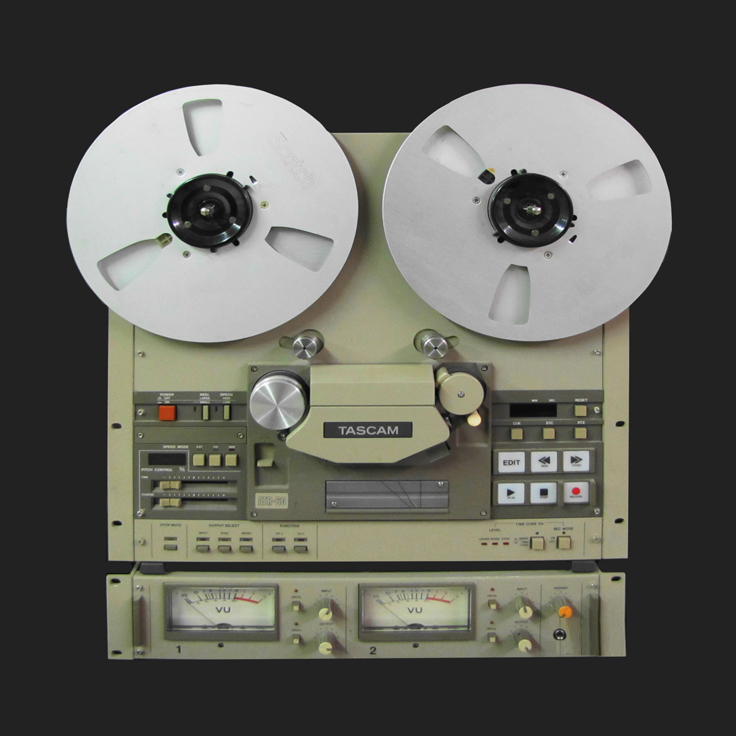
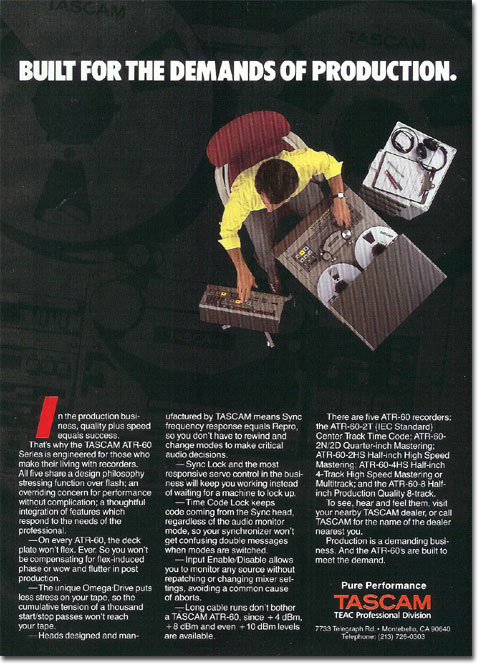 The TASCAM ATR-60 Series. The ATR-60's were engineered for those who made their living with recorders. All six models shared a design philosophy stressing function over flash...efficiency paced by the right balance of features without excess. Refined and tempered by experience and materials to meet the harshest and most demanding environments with poise, speed, and tenacity, the ATR-60's were at home in any audio or video production facility.
The TASCAM ATR-60 Series. The ATR-60's were engineered for those who made their living with recorders. All six models shared a design philosophy stressing function over flash...efficiency paced by the right balance of features without excess. Refined and tempered by experience and materials to meet the harshest and most demanding environments with poise, speed, and tenacity, the ATR-60's were at home in any audio or video production facility.
ATR-60/2N Professional 1/4" 2 channel half-track recorder.
ATR-60/2T Professional 1/4" 2 channel half-track with center track time code.
ATR-602HS Professional 1/2" 2 channel half-track mastering recorder
ATR-60/4HS Professional 1/2" 4 channel mastering recorder
ATR-60/8 Professional 1/2" 8 channel 8-track production recorder
ATR-60/16 Professional 1" 16 channel 16-track production recorder
The TASCAM 200 series mixers. Sound reinforcement, studio recording, broadcast and video production is what the TASCAM 200 series was built for. They were available in three models.
M-208 (8x4x2)
M-216 (16x4x2)
M-224 (24x4x2)
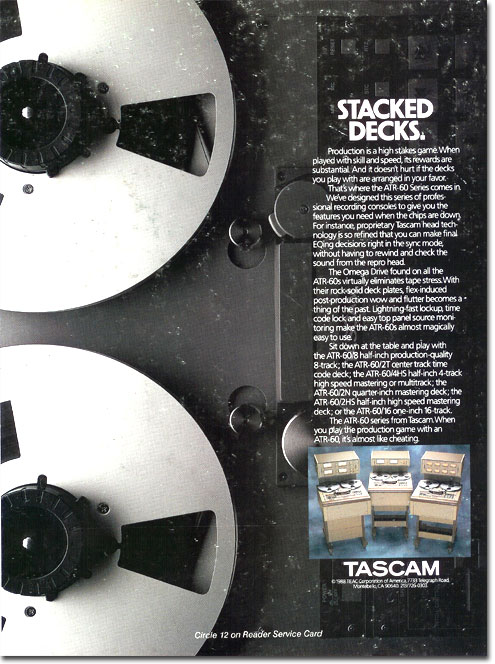
1986 TASCAM introduced its first cassette duplicator and slave units, the T-2620MS, T-26202S, T-2640MS and T-26402S.
TASCAM added new models to enhance the profession lineup of cassettes decks. The TASCAM 112 was a basic 2-head machine that fully maintained the professional quality performance, stability and reliability of the top-of-the-line 122MKII. The TASCAM 112R was the deck of choice for professional applications requiring extended playback and record capability. The 112R was an auto reverse cassette deck using the unique symmetrical bi-directional transport with super-acculign rotating head.
The TASCAM 246 replaced the 244. It allowed the recording of all four channels at once, and had six inputs instead of just four. It also allowed the option of running the cassette at double speed or at the normal speed of 1 7/8 IPS. 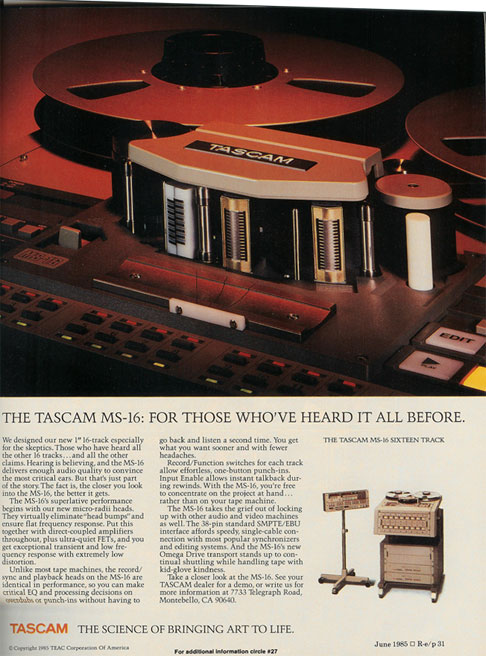
1987 TASCAM introduced the MS-16, its first 16-track multitrack recorder with SMPTE. With a price point of under $8,000, and the addition of SMPTE, this 15 IPS recorder strengthened TASCAM's position in the 1" 16 track audio market.
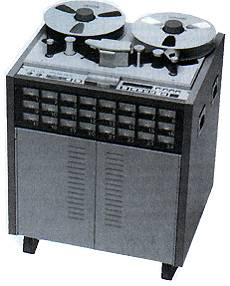 TASCAM introduced its first 2", 24-track recorder, the ATR-80/24. This multitrack was configured for +4 (in and out). The first A/B test of the ATR-80/24 was performed against the two most popular manufacturers of 2" recorders, MCI and Otari, at Lion's Share Recording Studios in Los Angeles. In performance specs and audio quality the ATR-80/24 equaled both the Otari and the MCI recorders in every respect.
TASCAM introduced its first 2", 24-track recorder, the ATR-80/24. This multitrack was configured for +4 (in and out). The first A/B test of the ATR-80/24 was performed against the two most popular manufacturers of 2" recorders, MCI and Otari, at Lion's Share Recording Studios in Los Angeles. In performance specs and audio quality the ATR-80/24 equaled both the Otari and the MCI recorders in every respect.
The TASCAM M-600 Series mixing consoles were developed in response to popular demand for TASCAM quality in a larger console designed specifically for the professional recording environment. The result was a high-performance console that offered broad mixing control and versatility while at the same time being remarkably compact and easy to use. 24 and 32 input channel versions were available.
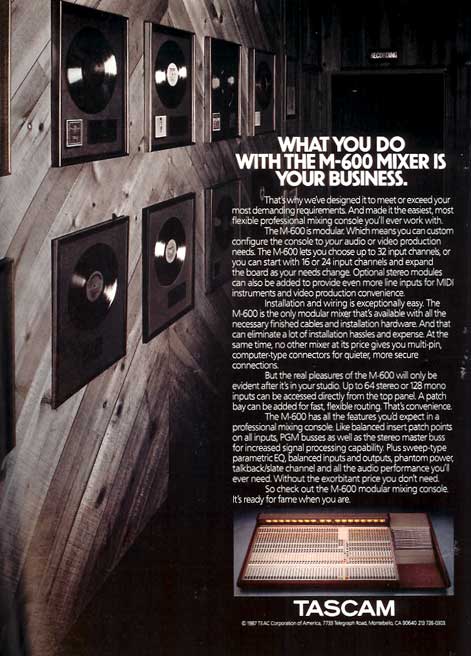
The 122MKII continued TASCAM's leadership in the professional cassette market. The new features included Dolby HX PRO, the ability to locate, a zero return function, and pitch control.
TASCAM introduced the CD-501, the best CD player available featuring ZD circuitry, dual D/A convertors, on-the-fly programming, and balanced XLR outputs at a suggested retail of $1,095.
TASCAM introduced the PORTA 05 self-contained 4 in/2 out production 4-track system, a truly compact, convenient creative companion.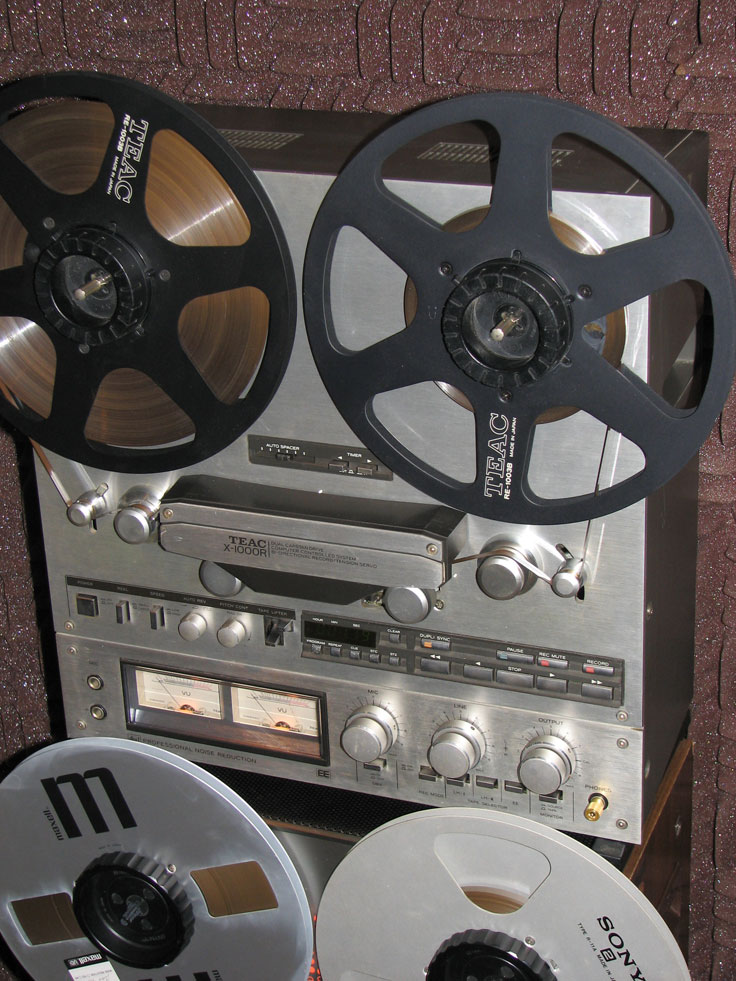
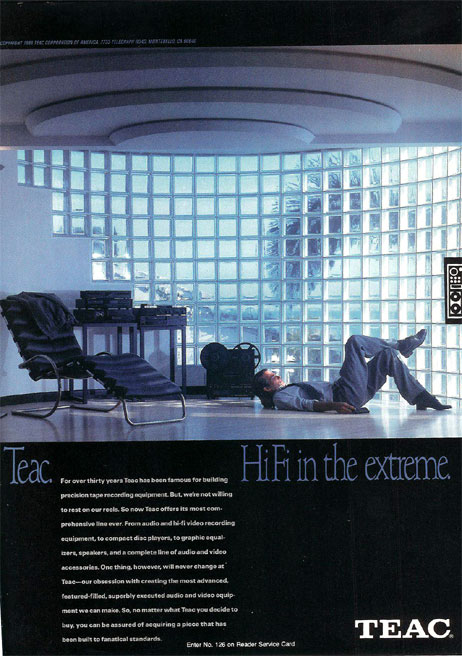 TASCAM introduced the PORTA TWO, a battery-powered, self-contained 4-track recorder with 6-input mixer and effects buss.
TASCAM introduced the PORTA TWO, a battery-powered, self-contained 4-track recorder with 6-input mixer and effects buss.
Teac brought out the X-1000R reel to reel consumer tape recorder in 1987. The Phantom Productions, Inc.'s Reel2ReelTexas.com has the unit pictured right.
1988 TASCAM introduced its first synchronizer, the ES 50, along with the ES 51 controller.
The TASCAM MSR-16 was a 16-track that recorded on 1/2" tape. The MSR-16 was a remarkable recording machine that made first-class performance and features available in a convenient format. The MSR-16 ran at both low (7.5 IPS) and high (15 IPS) speeds.
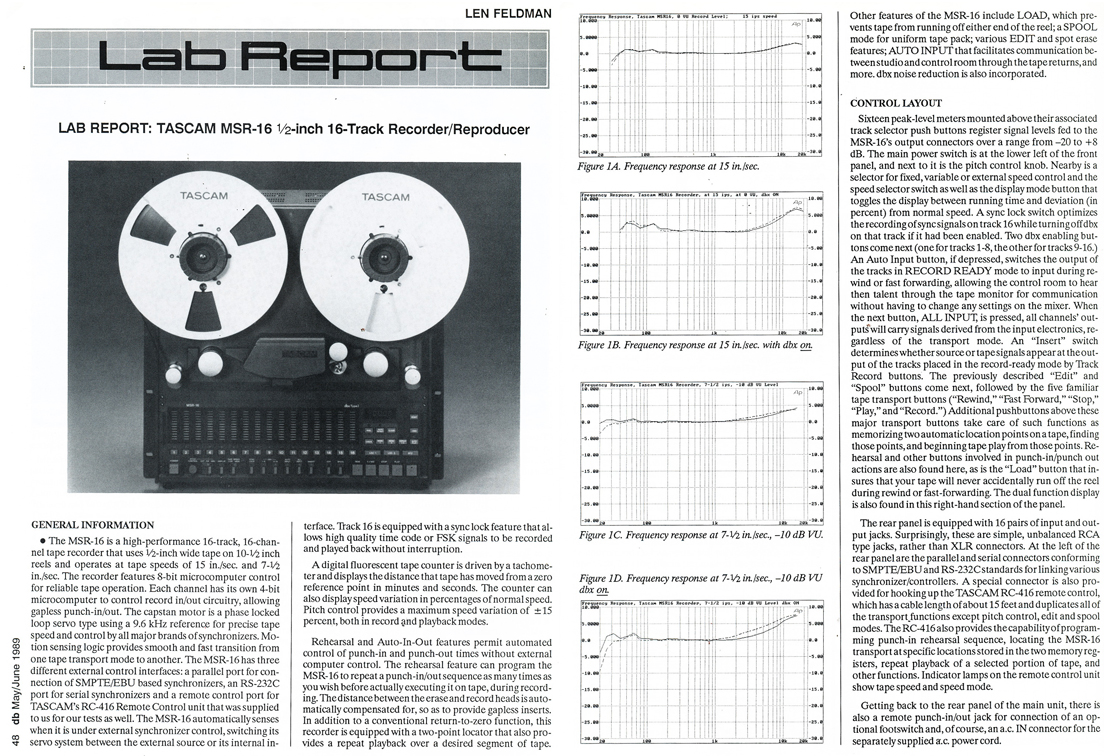
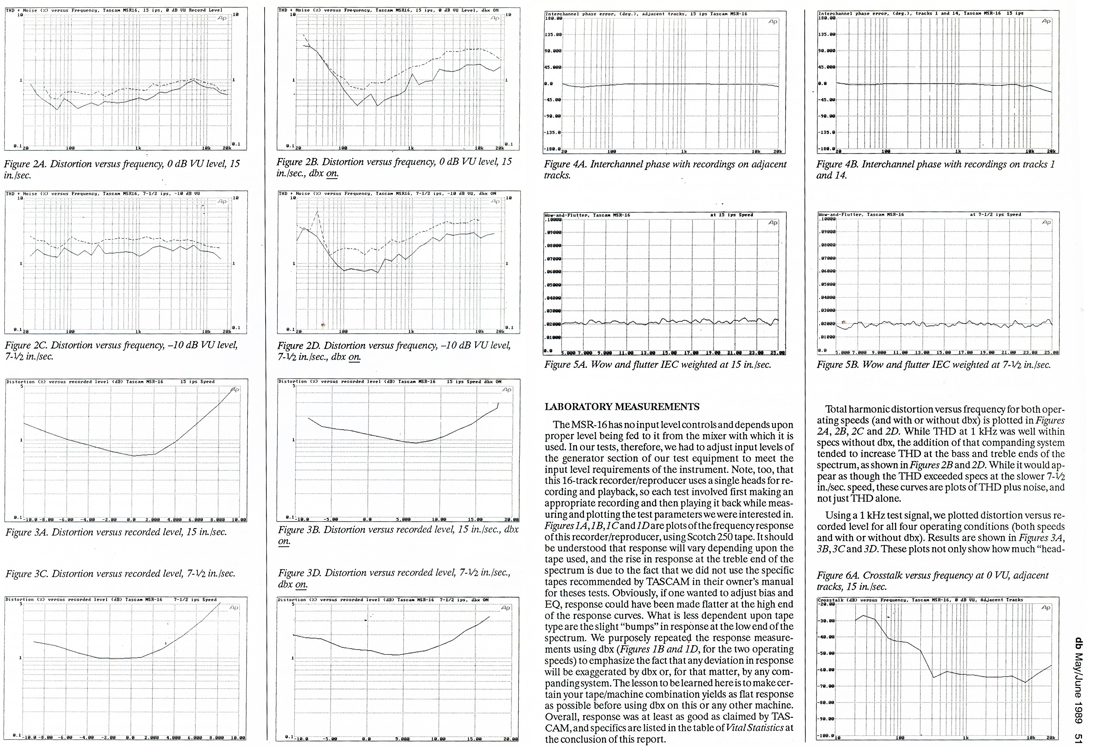
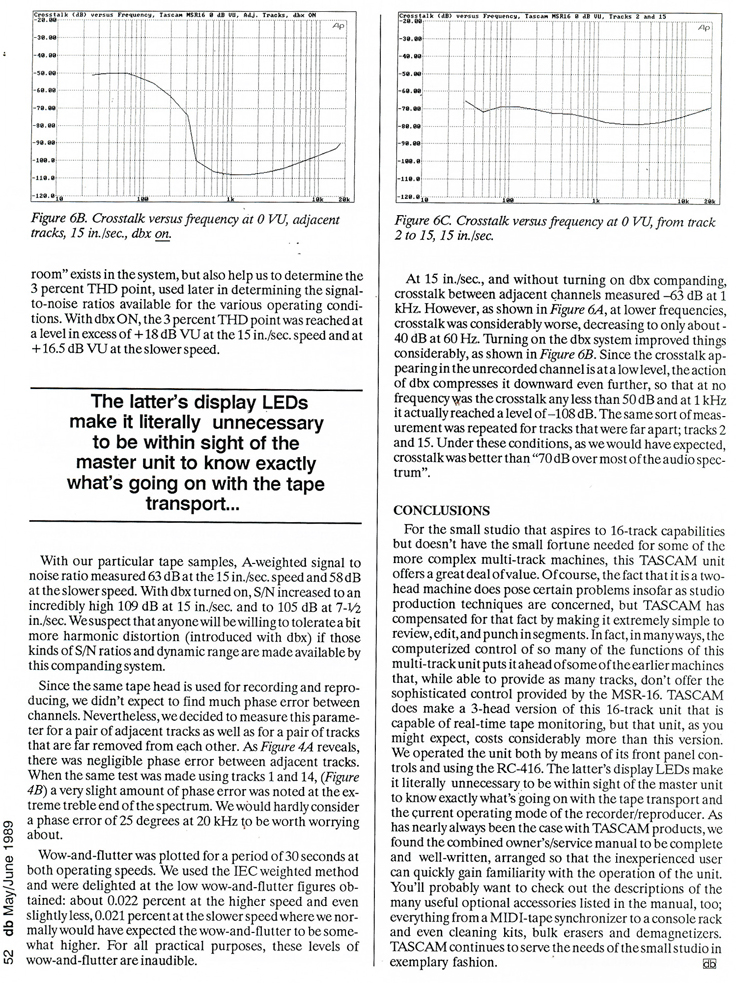
1989 TASCAM introduced its first 8-track, 8-channel cassette decks, the 238 Syncaset and the 238S Syncaset with Dolby S Noise Reduction. These models marked theintroduction of Dolby technology into TASCAM products.
TASCAM introduced its first DAT recorder, the DA-5O R-DAT. This recorder had a rotary head, as opposed to a stationary head (S DAT). The unit originated out of TEAC's sp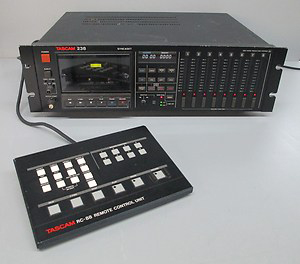 ecial high end products division. It was re engineered for TASCAM's use in their professional audio division. The DA-5O paved the way for the highly successful line of TASCAM DAT recorders.
ecial high end products division. It was re engineered for TASCAM's use in their professional audio division. The DA-5O paved the way for the highly successful line of TASCAM DAT recorders.
TASCAM introduced its first 4 track, 4 channel PORTASTUDIO with MIDI capabilities, the 644 MIDISTUDIO (list price $1,499). Music magazines in the industry hailed the unit in such a positive light that sales skyrocketed. Its success paved the way for the TASCAM 688 MIDISTUDIO (shipped later that same year), which boasted 8 tracks and 8 channels and a 20 input mixer, all for $3,299.
TASCAM introduced the M700, a 40x32 mixer. This was TASCAM's first mixer featuring built-in automation. The mixer had the familiarity of a traditional console and performed like more expensive consoles. It was dubbed the baby SSL. (A fader package was introduced at a later date.)
The TASCAM 102 was a cost effective 2-head stereo mixdown cassette deck. The 102 featured Dolby HX PRO, B, and C noise reduction.
The TASCAM 103 was a cost effective 3-head stereo mixdown cassette deck. The 103 also featured Dolby HX PRO, B, and C noise reduction.
The TASCAM 202WR was the first dual-well stereo cassette deck that offered the musician a cost-effective method of both dubbing copies and mixing down tracks.
The TASCAM 3030 represented a cost effective approach to broadcast two track audio production. The 3030 had a 4 head system --- 2 track, 2-channel erase, record reproduce and 4-track 2-channel reproduce. The 3030 also had mic inputs for simple direct voice-over spot production.
The TASCAM MTS-1000 was a sophisticated synchronization device allowing MIDI sequencers or other MIDI devices to be precisely synchronized to SMPTE-based recording equipment. It would also allow you to lock up two tape machines.
The TASCAM TSR-8 was an 8-track recorder using 1/2" tape on 10 1/2" reels with the ability to synchronize to other machines using the MTS1000 or the ES-50/ ES-51.
The TASCAM CD-401 was a rackmountable CD player with XLR balanced outputs and optional remote control.
The TASCAM CD-701 was a professional CD player with XLR outputs and first frame audio cue.
1990 TASCAM introduced its first 1" 24 track recorder, the MSR-24 for an unheard of price of $13,999.

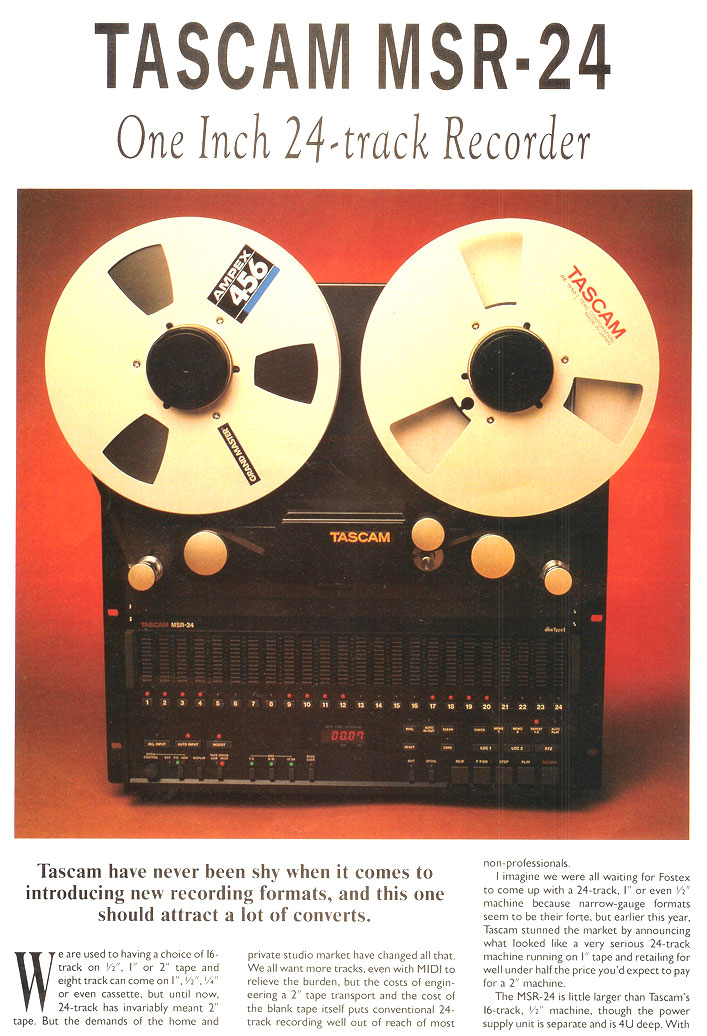

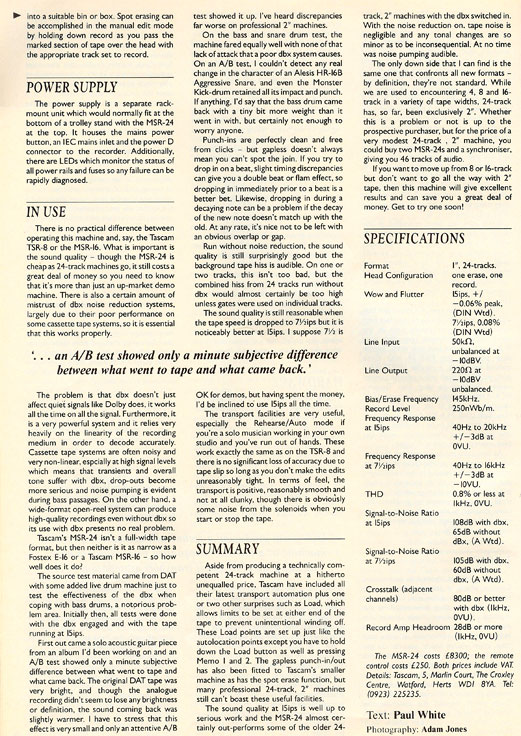
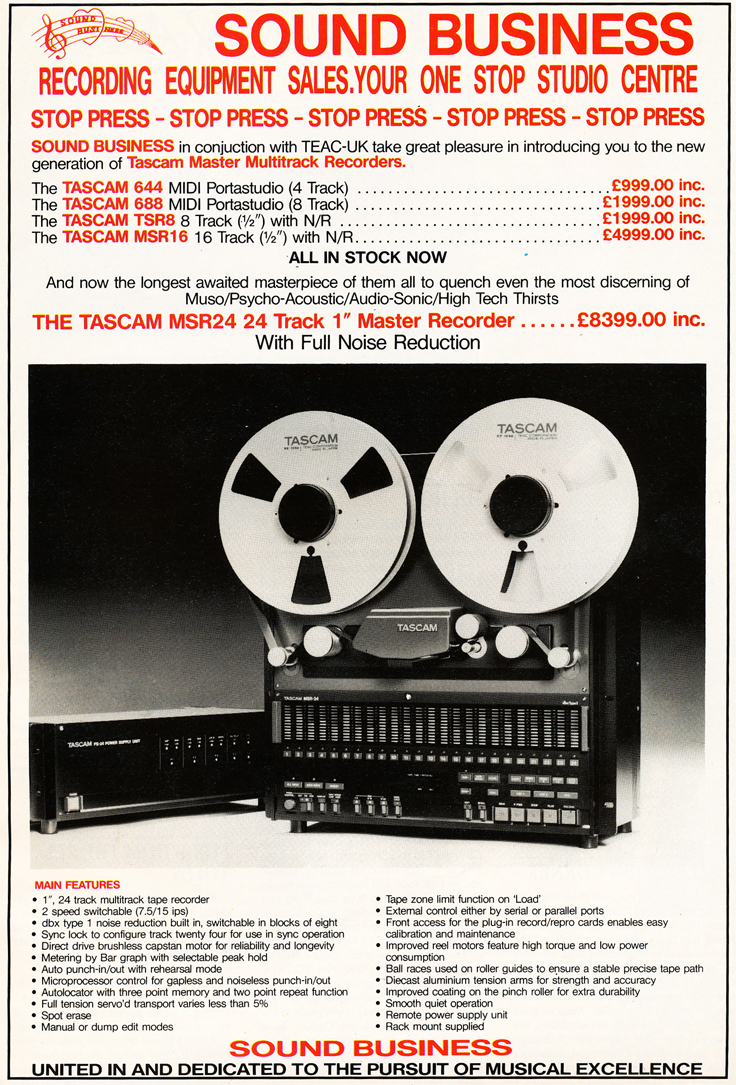
TASCAM introduced the DA-30, a 2 track DAT master recorder for $1,899. With DAT rapidly becoming the mastering format of choice for the music industry, the DA-30 quickly became an industry standard.
TASCAM introduced its first DASH multitrack, the DA-800/24 with S/PDIF-2 digital I/O. This was a cooperative developmental effort between TEAC (TASCAM), SONY and PANASONIC in an effort to standardize SONY's existing 24 track DASH format.
TASCAM introduced the M-3700, a 24x8 recording console with a choice of either dynamic or snapshot VCA automation.
The TASCAM M-3500 was an 8-buss console with in-line monitoring. The M-3500 was available in two different frame sizes to accommodate 24 and 32 channel configurations, and three standard models were available.
1991 The DA-P20 was TASCAM's first portable DAT machine. The product sold out overnight and proved that that the portable DAT was an important new category.
The TASCAM CD-601 was a professional CD player with XLR outputs.
The TASCAM M2500 Series was an 8-buss recording console with in-line monitoring and MIDI mute automation. The M2500 series included the 24-input M-2524 and the 16-input M-2516.
The TASCAM M1000 Series were live performance stereo mixers. The M1000 series included the 16-input M1016 and the 24-input the M1024.
The TASCAM 1500 Series were 4-buss recording consoles with 8 directly assignable outputs. The M1500 series included an 8-input version, the M1508, and a 16-input version, the M1516.
The TASCAM 202MKII was a dual transport, twin record dubbing deck.

Teac/Tascam analogue reel tape recorders end here!
1992 Tascam released its last professional reel to reel tape recorder, the BR-20 and the BR-20T (with time code channel)
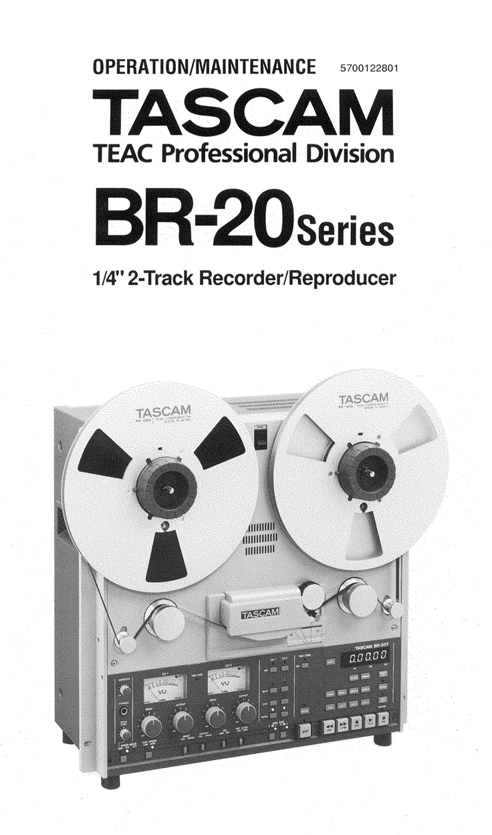
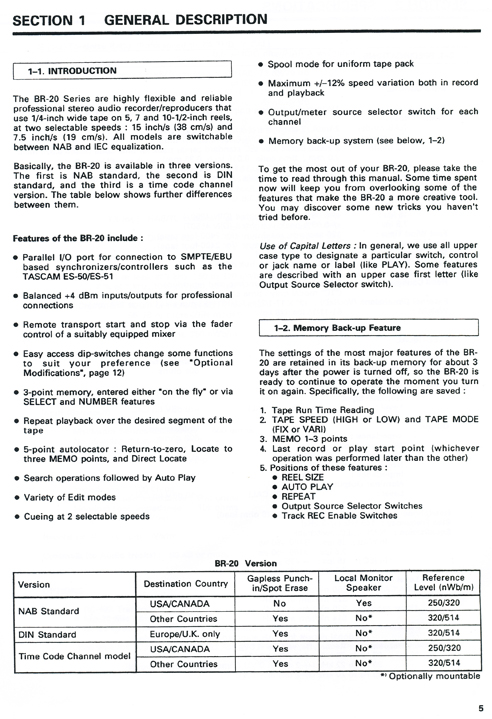

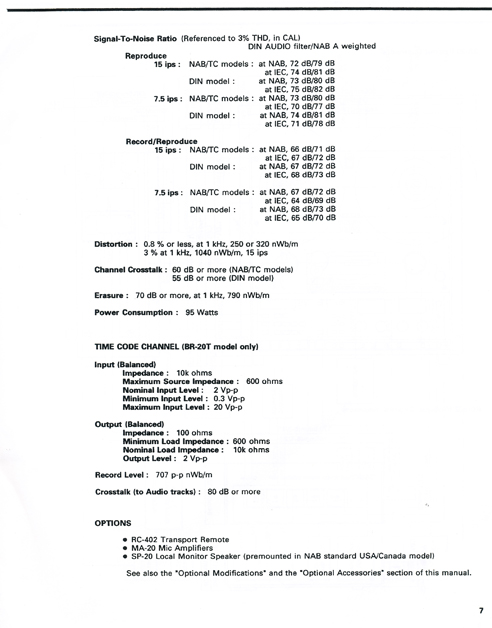
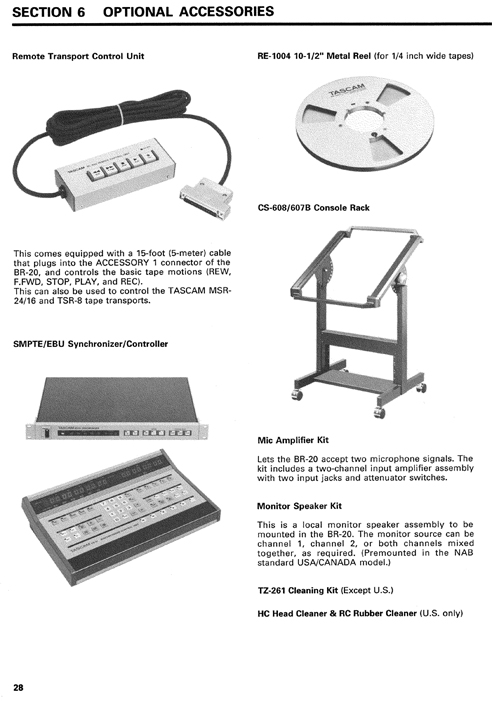
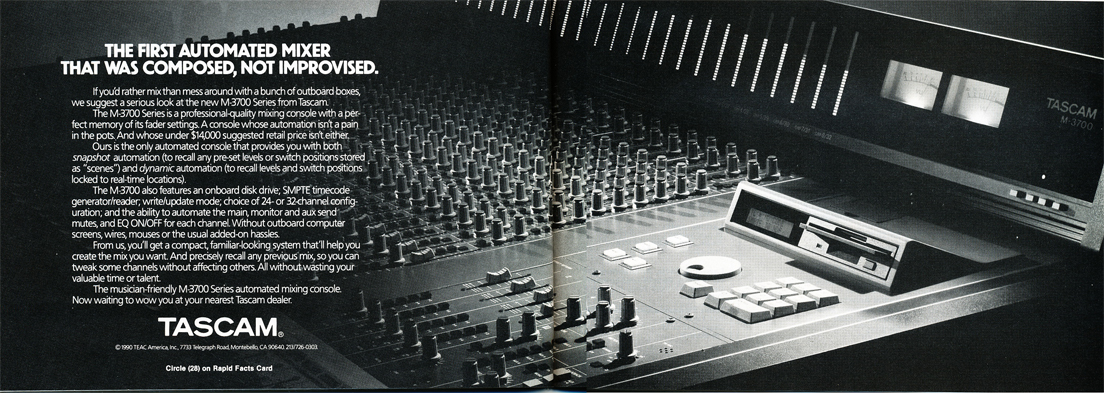
1993 TASCAM introduced the legendary DA-88 DTRS modular digital multitrack recorder. This still popular digital 8-track recorder was the first modular digital multitrack recorder to utilize the Hi-8 mm format. With the introduction of the SY-88 synchronizer card (time code reader/generator) a few months later the DA-88 became a standard in film/video post production, and eventually, in the music production market as well.
The TASCAM DA-60 was a 4-head DAT recorder able to lock to time code with the addition of an optional sync card.
The TASCAM PORTA-07 was a 4-input, 4-track cassette recorder.
The TASCAM 122MKIII was an upgrade of the highly successful model 122MKII. The 122MKIII incorporated a new and improved transport assembly.
1994 TASCAM introduced the DA-P1, which today remains a standard in professional portable DAT recorders.
The TASCAM MM100 and MM200 were keyboard mixers with 16 line inputs and stereo outputs plus four effects sends. The MM200 was the same as the MM100 except it had MIDI patching and built-in BBE processing.
The TASCAM M5000 was a sophisticated production mixer which was available with automation (M5000MFA). It was a 24-buss I/O console that was expandable to 40 inputs. It was sold complete with integral patch bays and stand.
The TASCAM M2600 Series were 8-buss recording consoles with in-line monitoring. The M2600 series included the 32 input M-2600/32, 24-input M-2600/24, and the 16-input M-2600/16.
1995 TASCAM introduced its first Mini Disc recorder/player, the MD-801R, along with the "play only" MD-801P.
The TASCAM CD201 was a rackmountable CD player with cue to music.
The TASCAM 302 was introduced and is still highly popular today. The 302 is a double auto-reverse bi-directional cassette deck containing two fully independent cassette decks housed in a 3U rackmountable enclosure. Each deck is capable of recording individually of simultaneously, and each deck contains its own discrete set of interface connectors, transport controls keys, noise reduction functions, and LED peak meters.
The TASCAM M-2600MKII Series was an upgrade of the M-2600 series, providing the additional ability to add a meter bridge and switchable -10dBv or +4 dBm signal levels for tape in and group outputs.
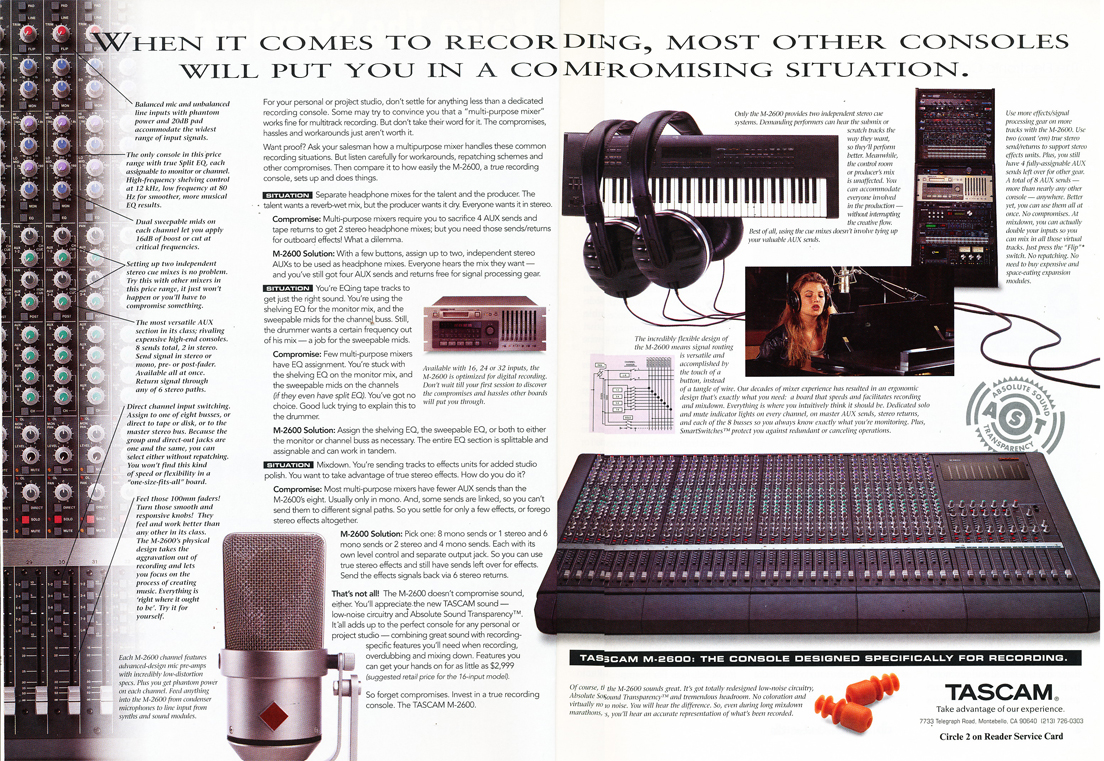
The TASCAM DA-20 was a very economical 3U rackmountable DAT recorder with wireless remote control.
The TASCAM M-1600 Series were 8-buss recording consoles with in line monitoring. The M1600 series included the 16 input M-1600/16 and the 24-input M-1600/24.
The TASCAM DA-60MKII was introduced and remains popular today. The DA-60MKII is an upgraded version of the DA-60 with an improved servo system that allows continuous time code recording in the assemble mode. It also has an improved signal to noise ratio, extended dynamic range and a built in chase lock synchronizer supporting Sony P2 protocol.
The TASCAM CD-305 was introduced and still remains popular today. It is a rack mountable CD changer that will hold five CD's.
The TASCAM M-08 was introduced. Still popular today, the M-08 is a compact utility mixer with 4 mono and 4 stereo inputs, XLR balanced mic inputs and 2 band EQ.
The hugely popular TASCAM DA-38 was introduced. Still a best-seller, the DA-38 is an 8 track DTRS digital audio recorder which does not feature the time code ability of the DA-88 and DA-98.
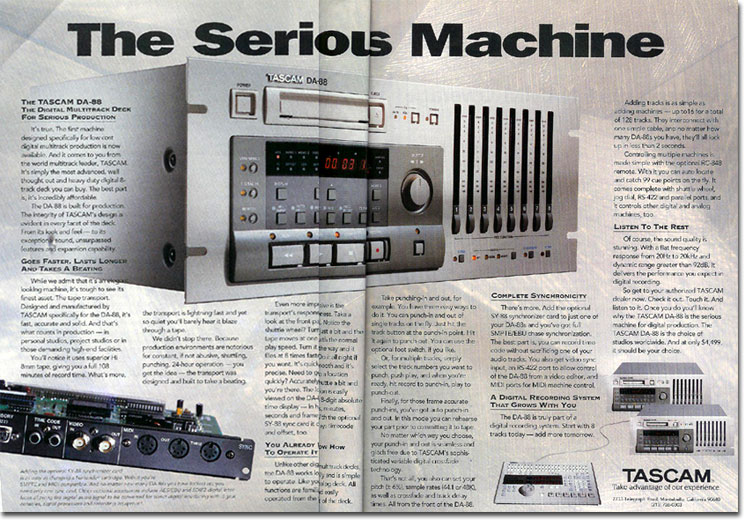
1997 TASCAM introduced the 564, the first Mini Disc multitrack DIGITAL PORTASTUDIO.
TASCAM introduced the DA-98, an 8 track DTRS recorder utilizing the same Hi-8 mm format as the DA-88. Now an industry standard, the DA-98 is a more sophisticated version of the DA-88, with the addition of confidence monitoring and built-in synchronization capability. The DA-98 has been specifically designed to meet the exacting requirements of the high end film/video post production market.
TASCAM introduced its first digital mixer, the 40x8 TM-D8000.
TASCAM introduced the still popular DA-302, the world's first dual DAT deck.
1998 TASCAM introduced the widely respected and still popular MMR-8, its first random-access, hard-disk digital multitrack recorder, and winner of the 1999 Post Magazine "Multitrack Recorder of the Year" award. The MMP-16 16-track "play only" version was introduced several months later.
TASCAM introduced the still hugely popular TM-D1000, the world's first digital mixer with a "street price" under $1,000. Featuring a wide variety of analog and digital I/O, built-in dynamics and effects processing, snapshot automation, and a host of other features, the TM-D1000 has been recognized for its versatility as evidenced by the wide variety of applications end-users have found for it...multi-track recording, multitrack mixdown, mixing live sound, MIDI system mixing, sound-for-video mixing, hardware control of computer-based recording, etc...$1,299 list.
TASCAM introduced the still popular DA-45HR, the world's first 24-bit R-DAT recorder, and winner of the PAR (Pro Audio Review magazine) Excellence, Studio Sound (magazine), and Key Buy (Keyboard magazine) awards for recording innovation...$2,165 list.
TASCAM introduced the CD-R400W and CD-R400M, its first computer CD burner bundles for both the Wintel and Macintosh platforms....$630 list.
TASCAM introduced the hugely popular CD-A500, an amazingly low cost CD player and auto-reverse cassette combination deck...$430 list.
1999 (January) TASCAM introduces the enormously popular CD-RW5000, its first stand-alone CD-R and CD-RW recorder...$1,299 list.
(January) TASCAM introduces the popular CD-D4000, its first personal CD duplicator...$1,299 list.
(July) TASCAM introduces the CD-R624W and CD-R624M, the world's first CD burner bundles that enable the end-user to create MP-3 files...$749 list.
(September) At AES, TASCAM introduces the MX-2424, the world's first 24-track, 24-bit HD recorder, priced at a mere $3999 list. Offering high-resolution recording, full editing capabilities, time-code generating and chasing and a flexible I/O structure, the MX-2424 set a new standard for the next millennium. (For detailed information on the MX-2424, go to the MX-2424 page.)
TASCAM introduces the DA-78HR, the world's first 24-bit MDM. Fully compatible with all other DTRS recorders, the DA-78HR allowed users to add 24-bit capability to their existing systems.
2000 Recognizing the fact that many musicians and studios were turning to software-based recording tools, TASCAM partnered with Frontier Design Group to apply their hardware expertise to this growing market. The result was the US-428, announced at the Winter NAMM show. The US-428 was crated with two purposes: first, as a high-quality audio and MIDI interface for computer audio. But the US-428 also offered the innovative capability of providing faders and knobs that gave real-time control over the software interface. For the first time, computer-oriented musicians and composers would not have to use a mouse to perform all needed adjustments to their mixes.
TASCAM enters a whole new product market with the CD-302, a dual CD player designed for DJs. It marks the start of a new subdivision of the company - TASCAM DJ - that will go on to include a variety of popular, innovative tools for this exciting form of music creation. The CD-302 was the very first CD player with a scratch emulation, so that DJs who were accustomed to the sound and performance capabilities of vinyl could use it without sacrificing this important aspect of DJing.
At the Summer NAMM show in Nashville, TASCAM introduced the 788, a hard disk version of their famous Portastudio products. The 788 Digital Portastudio featured an internal hard disk as its recording medium, with a slew of features that could not have been accomplished in the cassette Portastudio format (built-in effects, copy/paste digital editing and much more). Quickly becoming a wildly popular part of the TASCAM line, the 788 was TASCAM's first foray into the field of integrated digital recording tools.
2001 The DM-24, which TASCAM accurately billed as "the world's most powerful small format digital mixer ever made", was shown to the public at the NAMM show. The DM-24 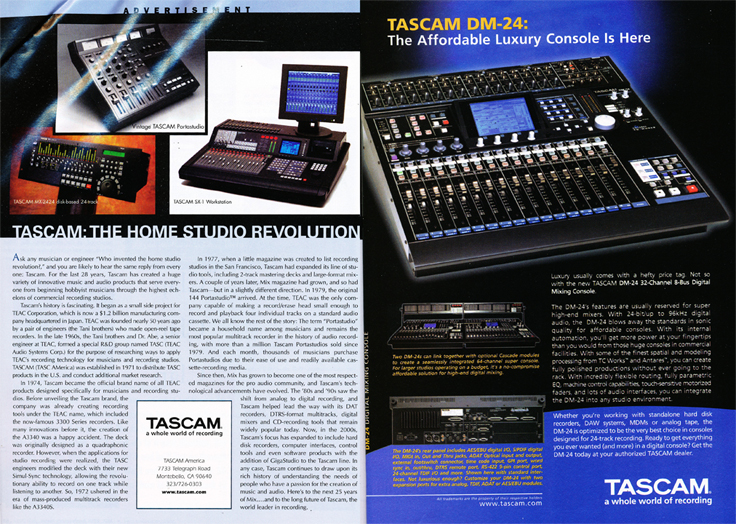 was the first affordable digital mixer with 96kHz digital capabilities, and offered luxury console features like touch-sensitive motorized faders, LED ring encoders, built-in effects by TC Works and Antares, and an incredibly powerful internal automation system. Perfect for standalone hard disk systems like the DM-24 as well as mixing control of DAW applications, the DM-24 went on to become one of TASCAM's most popular mixing tools ever made.
was the first affordable digital mixer with 96kHz digital capabilities, and offered luxury console features like touch-sensitive motorized faders, LED ring encoders, built-in effects by TC Works and Antares, and an incredibly powerful internal automation system. Perfect for standalone hard disk systems like the DM-24 as well as mixing control of DAW applications, the DM-24 went on to become one of TASCAM's most popular mixing tools ever made.
At the NAB show in Las Vegas, TASCAM announced the DS-D98. Designed at the bequest of Sony and based on TASCAM's DTRS recorders, the DS-D98 is the world's first tape-based recorder designed for Direct Stream Digital encoding, the basis of Sony's Super Audio CD (SACD) playback format. This technology records audio signals at a high sampling frequency of 2.8224 MHz, and converts them to 1-bit data for unprecedented sonic quality without the decimation and interpolation stages associated with conventional PCM technology.
In May, at the AES show in Amsterdam, TASCAM displayed one of their most technologically advanced products ever‚ ¨¶the SX-1 Digital Production Environment. A recording and composing workstation unlike any created before it, the SX-1 combined digital mixing, hard disk recording, MIDI sequencing, CD burning, sophisticated audio/MIDI editing and a huge variety of interfaces. Designed for music composition, recording studios, surround sound production, broadcast production and more, the SX-1 represented a huge cooperative engineering project between TASCAM's teams in Palo Alto (CA), Iruma Japan and partners such as TimeLine Vista.
TASCAM also introduced the CD-RW4U, an affordable desktop-based CD recorder, the MD-350, a MiniDisc recorder with improved data compression technology, and the CD-A630, a combination cassette deck and triple-CD player, early in 2001.
Later that year, TASCAM shocked the world of DJ performance tools with the introduction of the X-9 Digital DJ Mixer. More than just a standard mixer, the X-9 represented a brand new type of tool - the DJ production solution, with built-in effects, samplers and advanced sonic manipulation features.
TASCAM Gets Giga!
A special sidebar in 2001 was TASCAM's acquisition of NemeSys Music Technologies of Austin, Texas. NemeSys had been the creator of GigaSampler and GigaStudio, a revolutionary software-based sampler for PCs. Already in use by thousands of professional composers and musicians, Giga was the first tools that allowed samples to be streamed off a computer's hard drive instead of being limited to RAM storage. This patented technology, which was the only one to operate at the kernel level of a PC's architecture, allowed for samples up to 4GB in size.
The original founders of Giga in Austin remained with the TASCAM organization to continue developing the Giga platform, and became TASCAM's Austin Research Center for engineering.
An interesting side note: TASCAM was preparing for the Summer NAMM show in Nashville while the final details of the acquisition of NemeSys were taking place. TASCAM had already scheduled a press conference to announce this important milestone to the world on July 20, 2001. Fortunately, the final negotiations were settled in the afternoon of July 19, less than 24 hours before the announcement. Talk about late-breaking news!
2001 also marked the debut of the CC-222, a product that was spearheaded by TEAC Corporation of America's president Jimmy Yamaguchi. The CC-222 was the first combination CD recorder and cassette deck that offered RIAA equalized phono inputs, allowing for easy burning of CDs from vinyl LPs.
The fall of 2001, a busy year in TASCAM product development, had the introduction of the MX-2424SE, a special model of the MX-2424 that featured a built-in removable disk drive in the front panel. Also, TASCAM premiered the CD-RW402, a dual-CD recorder/player duplicator meant for small record labels, bands and musicians.
2002 The Winter NAMM show of 2002 was one of the biggest shows in TASCAM's history. There in Anaheim, California, TASCAM unveiled nine new products, the most at any single show in the company's history.
The most eagerly received product was the introduction of the Pocketstudio 5. Drawing upon the qualities that made the original Portastudios so well accepted, the Pocketstudio 5 added a high-tech angle to the act of capturing creativity on the spot by using Compact Flash as it recording medium. It also offered several tools never before found on a small integrated recording system, including an internal MIDI synth module, a USB port and the ability to mix songs down in MP3 format.
The CD-D1x4, an affordable cascadable multi-CD duplicator, was shown at NAMM of 2002.
Five of the new products marked TASCAM's true commitment to the DJ product market. Their five new DJ mixers (XS-3, XS-4, XS-8, X-15 and X-17) were designed to expand the range of TASCAM DJs to accommodate everyone from bedroom scratch DJs to professional mobile DJs.
The US-224, a "little brother" for the US-428, was also premiered. The US-224 not only represented an incredibly affordable tool for computer interfacing and control, but since it was self-powered via USB, it was also the most portable control surface made.
In showing their continued commitment to the Giga product line, TASCAM introed GigaStudio 32, a low-cost solution for people wanting to get into the power of Giga.
2008
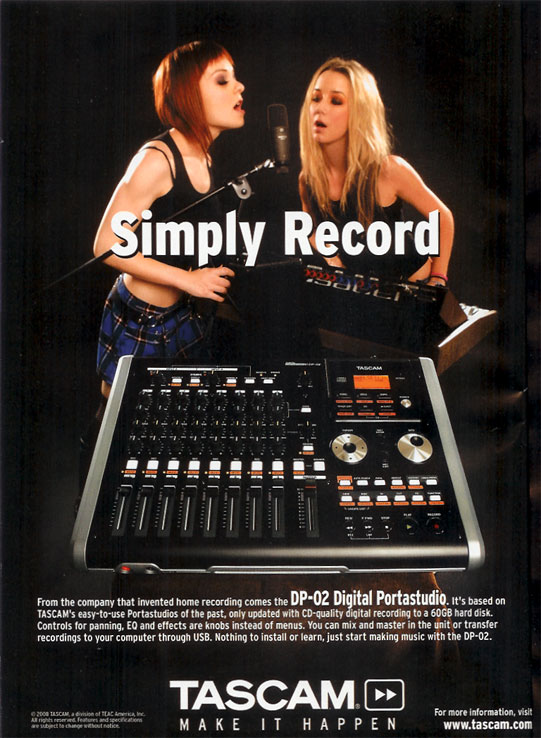
2009
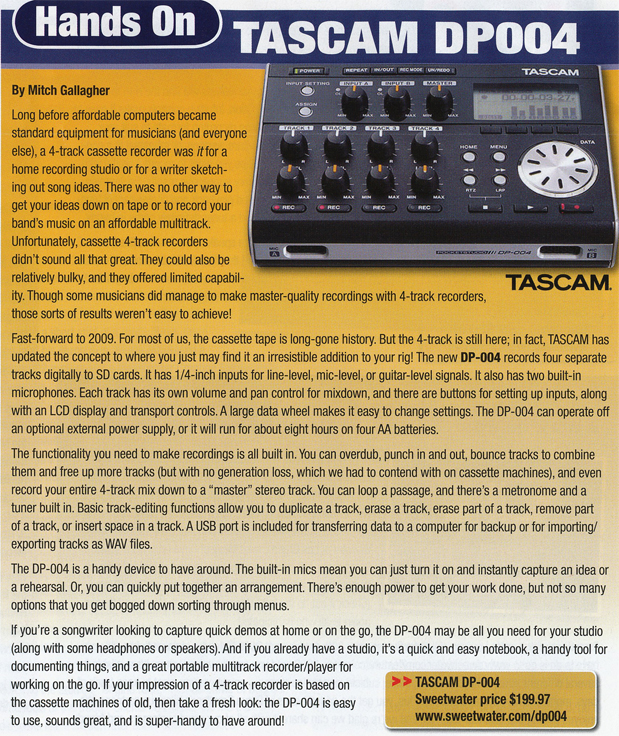
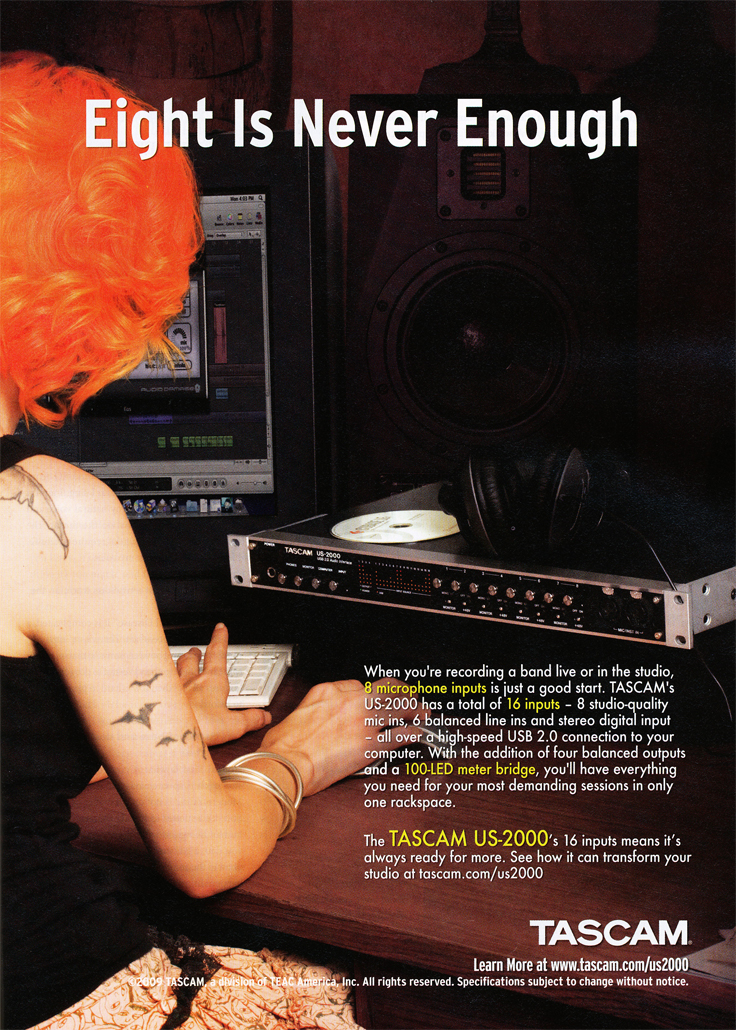
2011

2013
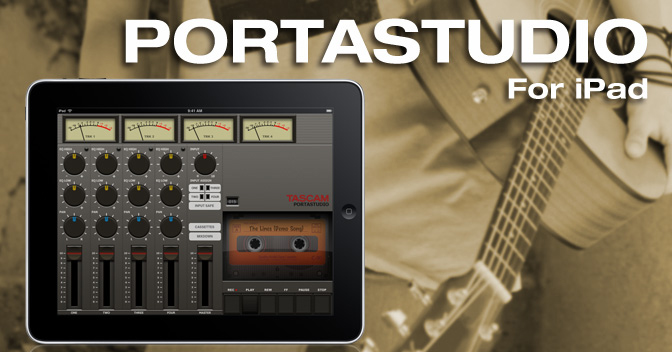
The Future
No one in the world can truly predict with complete accuracy the direction of technological innovation in any industry. TASCAM remains full of inspired visionaries that truly care about the direction of the music and audio products industries, and our plans for the short- and long-term future are bright. TASCAM will expand its presence into areas that allow its current expertise in hardware design to shine, as well as brand new areas that are being developed by leveraging all of its new technologies in software and hardware-based digital audio.
In other words, if you're wondering who the next leader in the world of music and audio solutions will be, you don't have to look far. TASCAM has been on top for nearly 30 years‚ ¨and that's where we'll remain.
Current
TASCAM - consumer to professional audio products, mostly recording
ESOTERIC - High-end consumer audio products
TEAC Consumer Electronics - Mass market audio products
Data Storage and Disk Publishing Products - Floppy drives,
DVD and CD recorders and drives, MP3 players & NAS storage
Esoteric Division • TEAC America, Inc.
7733 Telegraph Road, Montebello, CA 90640
Teac/Tascam models list rom our ads and catalog collection
| 1960 - Teac 505 |
| 1961 - Concertone 505 |
| 1966 - A-610, A-5050, A-4010S, A-3010, A-1200, A-4020, A-2020, A-1600, A-1500,R-310 |
| 1967 - R-1000, R-1100, A-4010, A-4020, A-2020 |
1968 - A-4010S, AS-200, A-6010, A-1200 |
| 1969 - R-310, A-1200U, A-6010, A-4010S, A-4010 SRA Quad |
| 1970 - A-100, A-1200, A-1500, A-1500U, A-6010, A6010U, A-7030, TCA-40, TCA-41, TCA-42 |
| 1971 - A-1200U, A-1500, A-6010U, A-7010U, A-7030U, A-3300, 4010SL, 6010SL, 7010SL, 7030SL, 3300-10, 3300-11, 3300-12, 1230, 1250, 4070, A-1200, TCA-40, TCA-41, TCA-42, An-180, AN-80, An-50 |
| 1972 - 2340, 3340, TCA-43 (1st Simul-Sync), A-4010GSL, 6010SL, AX-300, AN-300, A-6100, An-180, AN-80, Tascam Series 70, Tascam Model 10 mixer |
| 1973 - 1230, 1250, 4010GSL, 6010GSL, 7010GSL, 7030GSL, 4070GSL, 3300-10, 3300-11, 3300-12, 2340, 3340S, TCA-43, AX-300, AN-300, Tascam Series 70, Tascam Model 10 mixer |
| 1974 - TASCAM acquired by Teac, Tascam Series 70, Tascam Model 10 mixer, Model 5 mixer, Teac 2340, 3340S |
| 1975 - A-2300 SX, A-2300SD, A-3300SX, A-3300SX 2T, A4100, A-4300SX, A-6300, A-7300, A-7300 2T, A-3340S, A-2340SX, Model 2 mixer with MB20 meter bridge, AX-20 mix down box |
| 1976 - Tascam 80-8 (used for Star Wars R2D2 sound), Model 1, Model 10B, Teac A-7300RX, A-3300 2T,A-2340, A-3340, Model 3 mixer, Model 5 mixer, Series 80, 40-4 |
| 1977 - Tascam DX-8, Model 25-2, Tascam 80-8 (Star Wars released), 25-2, A-2300SX, A-2300SR, A-2300SD, A-3300SX, A-3300SR A-3300SX 2T, A-4300SX, A-6300, A-6600, A-7300, A-7300 2T,A-3340S, A-2340SX, Model 2 mixer with MB20 meter bridge, Model 5 & Model 5EX, Studio 4000, 40-4, Model 3 mixer |
| 1978 - Model 2 mixer, model 15 mixer, Tascam 80-8 (used for Star Wars R2D2 sound ads), Model 5A mixer, 25-2, Studio 8000, A-2300SD, A-3300SX 2T, A-4300SX, A-3300S, A-2300S, A-3340S, A-2340S, A-7300, A-6300, A-6100 |
| 1979 - Tascam 90-16, Teac 3440, Model 144 Portatudio, 80-8, 40-4, 35-2, 5B & 5BX, Model1, |
| 1980 - Tasccam 85-16, A-3440, A-3300SX 2T, A-2340SX, Model 2, MB20, A-6100MKII, GE-20 eq, 80-8, X-3, X-10R, ATR-700 built for Ampex, |
| 1981 - Tascam 80-16, System 20, Model 15SL mixer, 80-8, 40-4, Model 1 mixer, System 20, 22-2, 22-4, ATR-700 built for Ampex |
| 1982 - Tascam Model 15 SL, 80-8, Model 16 mixer, 85-16B, M-30, M-35 mixer, 32, 34, 38, 22-2, 22-4, Teac X-10, X-10R, X-20R, System 20, A-3440, X-1000R, ATR-700 and ATR-800 built for Ampex |
| 1983 - Tascam 38, Tascam 58, , ATR-700 and ATR-800 built for Ampex, 22-2, 22-4, Series 50 52, 58, 80-16B, System 20, M50 mixer, M-15B mixer, M-16 mixer, Series 30 - M-30, M-35, 34, 38 |
| 1984 - Teac X-300, X-300R, X-700R, X-2000, X-2000R BL |
| 1985 - Tascam 388, MS-16, Teac X-300, X-300R, X-700R, X-2000, X-2000R |
| 1986 - Tascam 388, 32, 34B, 38, Series 40, 42B, 44, Teac X-300, X-300R, X-700R, X-2000, X-2000R |
| 1987 - Tascam 388, MS-16, ATR-60, ATR-80/24, Teac X-300, X-300R, X-700R, X-2000, X-2000R |
| 1988 - Tascam Digital 24 track, 22-2, 32, 42B, M-600 mixer, ATR-60, ATR-60T, ATR-60-8, ATR-60-2N, ATR-60-2HS, ATR-60-16, Teac X-2000M(RO), X-2000(RO), X-2000R, X-300, X-300R |
| 1989 - Tascam MSR/24, MSR-16 |
| 1990 - Tascam MSR/24, MSR-16 |
| 1991 - Tascam M3000 mixer, MSR/24, MSR-16 |
| 1992 - Tascam BR-20, BR-20T |
| |
| |